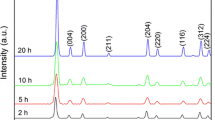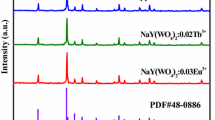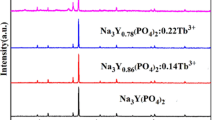Abstract
NaLa(WO4)2:Eu3+ phosphors with different Eu3+ concentrations have been synthesized by a hydrothermal method. The phase is confirmed by XRD analysis, which shows a pure-phase NaLa(WO4)2 XRD pattern for all of NaLa(WO4)2:Eu3+ phosphors. The SEM and TEM images indicate that all of NaLa(WO4)2:Eu3+ phosphors have a octahedral morphology. These suggest that the Eu3+ doping has no influence on the structure and growth of NaLa(WO4)4 particles. By monitoring the emission of Eu3+ at 615 nm, NaLa(WO4)2:Eu3+ phosphors show excitation bands originating from both host and Eu3+ ions. Under the excitation at 271 nm corresponding to WO4 2− groups, emission bands coming from the 1A1 → 3T1 transition with the WO4 2− groups and the 5D0 → 7Fj (j = 0, 1, 2, 3 and 4) transitions of Eu3+ are observed. The emission intensity relating to WO4 2− groups decreases with increasing Eu3+ concentration. But emission intensities of Eu3+ increase firstly and then decreases because of concentration quenching effect. Under the excitation at 395 nm corresponding to 7F0 → 5L6 transition of Eu3+, only characteristic Eu3+ emission bands can be observed. The results of this work suggest that tunable luminescence can be obtained for Eu3+ doped NaLa(WO4)2 phosphors by changing Eu3+ concentration and excitation wavelength.
Similar content being viewed by others
Avoid common mistakes on your manuscript.
1 Introduction
More and more attentions are paid to phosphor materials in recent years due to their applications in fields of solid state lighting [1], solar cells [2], sensors [3], medical and biological labels [4]. To meet the requirements of these applications, phosphors materials are expected to show high-efficiency and color controllable emissions, high physical and chemical stabilities, and so on. The luminescent properties of phosphor materials are affected by some factors, such as host, excitation wavelength, temperature, size and morphology. Rare earth ions play an important role in phosphor materials owing to their abundant emission colors originating from the 4f–4f or 5d–4f transitions [5]. For example, as one of widely used activators of red emission, Eu3+ often shows emission bands originating from 5D0 → 7Fj (j = 0, 1, 2, 3 and 4) transitions, whereas the relative intensity of these emission bands are influenced highly by the site of Eu3+ in the host. There will be a relative strong 5D0 → 7F1 transition and a relative weak 5D0 → 7F2 transition when Eu3+ locates a site without an inversion [6].
Double tungstates with the formula of MRE(WO4)2 (M = alkali-metal ions, RE = rare earth ions) are considered as potent candidates for the excellent physical and chemical stability and luminous efficiency [7]. The efficient energy transfer from the host matrix to the localized states of lanthanide ions also benefits the luminescent property. These materials have the scheelitr-type structure and contain the WO4 2− tetrahedral anions (W6+ is coordinated by four oxygen atoms in a tetrahedral site, and the RE3+/M+ site is eight coordinated). They exhibit excellent luminescence-property and can meet the various demands for exploring high-quality phosphor materials when they are doped with rare earth ions. A large number of rare earth ions doped double tungstates, such as NaGd(WO4)2:Tb3+ [8], NaLu(WO4)2:Eu3+ [2], NaLa(WO4)2:Er3+/Yb3+ [9], NaLa(WO4)2:Eu3+/Tb3+/Tm3+ [10], NaGd(WO4)2:Ho3+/Yb3+ [11] and NaGd(WO4)2:Tm3+/Dy3+/Eu3+ [12], have been synthesized successfully by different methods.
In this wok, we report on the hydrothermal synthesis of NaLa(WO4)2:Eu3+ phosphors. Hydrothermal method, as a typical solution-based approach, has been proved to be an effective and convenient synthesis technique for preparing uniform and well-dispersed phosphor particles. The hydrothermal process can be controlled by an appropriate choice of reaction parameters, such as temperature, time, pH value and surfactant. Moreover, low reaction temperature, mild reaction conditions, size-selective growth, controllable morphology, phase purity, smaller particle size, and narrow particle size distribution are the advantages of the hydrothermal synthesis method. We find that the obtained NaLa(WO4)2:Eu3+ phosphors have the octahedral morphology and the luminescence can be tuned by changing Eu3+ concentration and excitation wavelength.
2 Materials and methods
A series of NaLa(WO4)2:x mol%Eu3+ (x = 0, 3, 6, 9, 12 and 15) phosphors were synthesized by a hydrothermal process. La2O3 (99.99 %), Eu2O3 (99.99 %), (NH4)6W7O24·6H2O (AR) and NaNO3 (AR) were used as raw materials. NaOH (AR) was used to adjust the pH values. All raw materials were used directly without further purification. La(NO3)3 and Eu(NO3)3 solutions were obtained firstly by dissolving La2O3 and Eu2O3 into HNO3 with constant stirring and heating at about 50 °C until all materials were dissolved completely. The mole ratios of Eu2O3:La2O3 were 0, 3:97, 6:94, 9:91, 12:88 and 15:85, respectively. Then, (NH4)6W7O24·6H2O and NaNO3 were added to the above solution with stirring for about 30 min. The pH value of solution was adjusted to be 7 by adding appropriate NaOH, which induces the formation of suspension solution. The suspension solution was subsequently transferred into a 100 ml Teflon vessel and sealed in a stainless steel autoclave. The autoclave with its contents was treated under hydrothermal conditions for 10 h at 180 °C. When the reaction was completed, it was naturally cooled to room temperature and a white precipitate was obtained. Afterwards, the precipitates were filtered by centrifugation and washed several times using deionized water and ethanol. The final products were dried at 70 °C for 24 h in air.
The X-ray powder diffraction (XRD) measurements were carried out on a Rigaku-Dmax 2500 diffractometer using Cu Kα radiation (λ = 0.15405 nm). The morphologies and microstructures were studied by scanning electron microscopy (SEM, Hitachi S-4800) and transmission electron microscopy (TEM, JEOL-2100F). Selected-area electron diffraction (SAED) and high-resolution TEM (HRTEM) were examined on a JEM-2010F high-resolution transmission electron microscope. The luminescence was performed on a HitachiF-7000 spectrophotometer equipped with a 150 W xenon lamp as the excitation source.
3 Results and discussion
The phase of obtained NaLa(WO4)2:Eu3+ phosphors has been confirmed by XRD analysis. It is clear from Fig. 1 that all diffractions are well according with the pure-phase NaLa(WO4)2 (JCPDS No. 79-1118) and no secondary phase is detected. This indicates that the phosphors doped with different Eu3+ concentrations remain a single phase. According to the effective ionic radii of cations, Eu3+ (1.066 Å for CN = 8) ions are proposed to occupy the sites of La3+ (1.160 Å for CN = 8) or Na+ (1.180 Å for CN = 8). However, on the basis of the valence state analysis, the Eu3+ ions are much more probably occupying the La3+ sites. The diffraction peaks shift slightly to higher 2θ angles with the increasing Eu3+ concentrations because of the substitution of La3+ by Eu3+ and the smaller ionic radius of Eu3+ comparing with La3+. The lattice parameters were calculated using least square refinement program CHECKCELL. The calculated lattice parameter as a function of Ca concentration is shown in Fig. 2. The above results suggest that the Eu3+ ions have been effectively incorporated into the host lattices by replacing La3+ sites without altering the host structure and the well-crystallized NaLa(WO4)2:Eu3+ samples can be obtained under the present hydrothermal conditions.
Figure 3 gives the SEM (Fig. 3a) and TEM (Fig. 3b) images of NaLa(WO4)2:12 mol%Eu3+ phosphors. From images, one can see that monodispersed particles with a well-defined octahedral morphology are obtained. Generally, the Ostwald ripening process is a well accepted mechanism for the crystal growth. In the Ostwald ripening process, the initial formation of tiny crystalline nuclei in a supersaturated medium is followed by crystal growth. In this process the larger particles grow at the cost of the small ones due to the energy difference between large particles and small particles. Initially, the mixture solution containing La(NO3)3, Eu(NO3)3, NaNO3 and (NH4)6W7O24 with a pH value of 7 yields the formation of abundant amorphous NaLa(WO4)2:Eu3+ particles, which serves as precursors of the crystal. Next, the hydrothermal process induces the crystallization, in which amorphous particles nucleate and hydroxyl anions are adsorbed selectively. Finally, the crystal grows with certain faces and octahedral crystals are formed. All of NaLa(WO4)2:Eu3+ phosphors with different Eu3+ concentrations have similar morphology, indicating that the Eu3+ concentration has no influence on morphology. The bright spots in the SAED pattern (Fig. 3c) demonstrate the single crystalline nature of NaLa(WO4)2:12 mol%Eu3+ phosphors, which is in accordance with the clear lattice fringes in the HRTEM image in Fig. 3d. Additionally, the distance between two adjacent lattice fringes was calculated to be 0.294 nm, which corresponds with the (004) plane of tetragonal NaLa(WO4)2.
Figure 4 shows the excitation spectra of NaLa(WO4)2 and NaLa(WO4)2:12 mol%Eu3+ phosphors by monitoring 615 nm emission of Eu3+. Both NaLa(WO4)2 and NaLa(WO4)2:12 mol%Eu3+ phosphors have a strong and broad band ranging from 200 to 350 nm with a maximum at about 271 nm, which is the charge transfer band (CTB) of WO4 2− groups and O2− → Eu3+ transition from an oxygen 2p state excited to an Eu3+ 4f state. Mostly, the contribution of these two transitions cannot be distinguished obviously because of the spectral overlap. For NaLa(WO4)2:12 mol%Eu3+, a series of sharp excitation lines in the range of 350–500 nm also can be observed, which is the typical intra-4f transitions of Eu3+. The excitation lines in this region come from 7F0 → 5D4, 7F0 → 5GJ, 7F0 → 5L7, 7F0 → 5L6, 7F0 → 5D3 and 7F0 → 5D2 transitions of Eu3+, respectively. Herein, the presence of excitation band of WO4 2− groups by monitoring Eu3+ emission suggests an energy transfer from WO4 2− groups to Eu3+.
Figure 5 shows the emission spectra of NaLa(WO4)2:x mol%Eu3+ (x = 0, 3, 6, 9, 12 and 15) phosphors under an excitation at 271 nm. All of Eu3+ doped NaLa(WO4)2 phosphors have similar profiles and each one consists of two parts: one is the broad band in the range of 350–575 nm with a maximum at about 468 nm and the other consists of several emission lines in the range of 575–725 nm. The broad band peaking at about 468 nm is due to the 1A1 → 3T1 transition with the WO4 2− groups. The pure NaLa(WO4)2 only has this emission band under excitation at 271 nm. The sharp emission bands with maximum at 590, 599, 615, 623 and 706 nm result from the 5D0 → 7Fj (j = 0, 1, 2, 3 and 4) transitions of Eu3+, respectively. The emission band peaking at 615 nm (originating from the 5D0 → 7F2 electric dipole transition of Eu3+) is strongest, suggesting that Eu3+ locates a non-symmetry site in NaLa(WO4)2 host. For NaLa(WO4)2:Eu3+ phosphors, the emission intensity of the host decreases gradually with increasing Eu3+ concentrations. The emission intensity corresponding to Eu3+ increases with increasing Eu3+ concentrations and reaches a maximum at x = 12. The concentration of Eu3+ more than 12 mol% in NaLa(WO4)2 host induces the decrease of Eu3+ emission due to the concentration quenching effect. The changes of emission intensity relating to transition of host and Eu3+ confirm the existence of energy transfer from the host to Eu3+ in NaLa(WO4)2:Eu3+ phosphors. But WO4 2− groups do not transfer all of the absorbed energy to Eu3+ ions so that the emission of host can be observed. Also, such energy transfer phenomenon demonstrates that the as-synthesized NaLa(WO4)2:Eu3+ is a solid solution, in which Eu3+ has successfully incorporated into NaLa(WO4)2 lattice, agreeing well with the XRD results [13].
Figure 6 shows the emission spectra of NaLa(WO4)2:x mol%Eu3+ (x = 0, 3, 6, 9, 12 and 15) phosphors under excitation at 395 nm. The results show that the excitation wavelength has obvious influence on the luminescence of NaLa(WO4)2:Eu3+ phosphors. There are only characteristic emission bands of Eu3+ ions, indicating that the energies absorbed by the 7F0 → 5L6 transition cannot be transferred to WO4 2− groups. This advises that excitation induced emissions are possible from the single emitting component by dissolving the suitable amount of Eu3+ ions in the calcium site due to WO4 polarization in the luminescence. This result is similar to that of CaMoO4:Eu3+ phosphors reported by Raju et al. [14]. But the dependence of Eu3+ emission on the Eu3+ concentration is similar to those of results obtained by 271 nm excitation.
In order to determine the energy transfer mechanism from host to activators in NaLa(WO4)2:Eu3+ phosphors, it is necessary to know the critical distance (Rc) between the neighbouring Eu3+ ions. The critical transfer distance (Rc) can be calculated by the formula of \({\text{R}}_{\text{C}} \approx 2\left( {3{\text{V}}/4\uppi{\text{XN}}} \right)^{{\frac{1}{3}}}\), where \({\text{X }}\) is the critical concentration of Eu3+, \({\text{V}}\) is the volume of the unit cell, and \({\text{N}}\) is the number of available sites of the dopant in the unit cell [15]. For NaLa(WO4)2 host, the values of V, X and N are 332.698 Å3, 0.12 and 2, respectively. The critical distance is calculated to be about 13.86 Å. With the increase of Eu3+ concentration, the energy transfer from the host to Eu3+ becomes more efficient, and the probability of energy migration between activators increases simultaneously. When the distance becomes small enough, the concentration quenching phenomenon takes place and the energy migration is hindered. In general, there are two main mechanisms for a non-radiative energy transfer process: one is exchange interaction, and the other is electric multipolar interactions [16]. The value of Rc acquired above indicates the little possibility of exchange interaction since it can be predominant only for about 5 Å. Hence, we can conclude that the energy transfer mechanism from the host to Eu3+ is dominated by the electric multipolar interactions.
It is well known that the intensities of the transitions between different J-number levels are dependent on the symmetry of the local environment of Eu3+ activators in terms of the Judd–Ofelt theory [6, 17]. The magnetic dipole transition (5D0 → 7F1, orange emission) will dominate if Eu3+ is in a site with inversion symmetry, whereas electric dipole transition (5D0 → 7F2, red emission) dominates when Eu3+ locates a site without inversion symmetry. Therefore, the luminescent intensity ratio of 5D0 → 7F2 to 5D0 → 7F1 (R/O) is used to measure the degree of distortion from inversion symmetry of the local chemical environment surrounding Eu3+ in the host. As shown in Figs. 4 and 5, the emission intensity of 5D0 → 7F2 is much higher than that of 5D0 → 7F1 for NaLa(WO4)2:Eu3+ phosphors. The R/O values of NaLa(WO4)2:Eu3+ phosphors with different Eu3+ concentrations are shown in Fig. 7. It reveals that the R/O values increase with the increasing Eu3+ concentrations, indicating Eu3+ occupies more distorted local environment. The color purity of Eu3+ doping phosphors can be characterized as the R/O value [18].
4 Conclusion
We have synthesized a series of NaLa(WO4)2:Eu3+ phosphors by a hydrothermal method. The Eu3+ doping has no influence on the phase structure and morphology of obtained NaLa(WO4)2:Eu3+ samples. The Eu3+ concentration in NaLa(WO4)2 host and the excitation wavelength have obvious influence on luminescence of NaLa(WO4)2:Eu3+ phosphors. Under the excitation at 271 nm corresponding to WO4 2− groups, emission bands coming from the 1A1 → 3T1 transition with the WO4 2− groups and the 5D0 → 7Fj (j = 0, 1, 2, 3 and 4) transitions of Eu3+ are observed. The emission intensity relating to WO4 2− groups decreases with increasing Eu3+ concentration. But emission intensities of Eu3+ increase firstly and then decreases because of concentration quenching effect. Under the excitation at 395 nm corresponding to 7F0 → 5L6 transition of Eu3+, only characteristic Eu3+ emission bands can be observed. The results of this work suggest that tunable luminescence can be obtained for Eu3+ doped NaLa(WO4)2 phosphors by changing Eu3+ concentration and excitation wavelength.
References
Y.Y. Cao, N.D. Liu, J. Tian, X. Zhang, Polyhedron 107, 78 (2016)
Y.M. Wang, H.B. Zhang, S.S. Qu, C.H. Su, J. Alloys Compd. 677, 266 (2016)
Z. Wei, W. Zheng, Z.Y. Zhu, X.F. Guo, Chem. Phys. Lett. 651, 46 (2016)
Y.X. Tang, R. Mei, S.K. Yang, H.X. Tang, W.Z. Yin, Y.C. Xu, Y.P. Gao, Superlattices Microstruct. 92, 256 (2016)
P. Li, U. Liu, Y.X. Guo, X.L. Shi, G.Q. Zhu, H.Q. Zuo, Ceram. Int. 41, 6620 (2015)
Y.G. Yang, Mater. Sci. Eng. B 178, 807 (2013)
Z.J. Wang, J.P. Zhong, H.X. Jiang, J. Wang, H.B. Liang, Cryst. Growth Des. 14, 3767 (2014)
Y.X. Liu, X.J. Yue, K. Cai, H.D. Deng, M. Zhang, Energy 93, 1413 (2015)
X.L. Liu, W.H. Hou, X.Y. Yang, Q.M. Shen, RSC Adv. 42, 11445 (2013)
X.L. Liu, W.H. Hou, X.Y. Yang, J.Y. Liang, CrystEngComm 16, 1268 (2014)
X.C. Yu, Y.B. Qin, M.L. Gao, L. Duan, Z.Q. Jiang, L. Gou, P. Zhao, Z. Li, J. Lumin. 153, 1 (2014)
Y. Liu, G.X. Liu, J.X. Wang, X.T. Dong, W.S. Yu, Inorg. Chem. 53, 11457 (2014)
Y. Zhang, W.T. Gong, J.G. Yu, Z.Y. Cheng, G.L. Ning, RSC Adv. 6, 30886 (2016)
G.S.R. Raju, E. Pavitra, Y.H. Ko, J.S. Yu, J. Mater. Chem. 22, 15562 (2012)
Z.-W. Zhang, A.-J. Song, S.-T. Song, J.-P. Zhang, W.-G. Zhang, D.-J. Wang, J Alloys Compd. 629, 32 (2015)
L.G. Van Uitert, J. Electrochem. Soc. 114, 1048 (1967)
A. Zaushitsyn, V. Mikhailin, A. Romanenko, E. Khaikina, O. Basovich, V. Morozov, B. Lazoryak, Inorg. Mater. 41, 766 (2005)
R. Krishnan, J. Thirumalai, S. Thomas, M. Gowri, J. Alloys Compd. 604, 20 (2014)
Acknowledgments
This work is financially supported by the General Project of Hebei North University (Nos. 2013003 and S201407), Science and Technology Department of Hebei Province Project (No. 16961301D), Zhangjiakou Science and Technology Bureau Projects (Nos. 13110038I-3, 12110058E−4, 11110024D and 1511075B), the Social Science Fund of Heibei Province (No. HB14JY075) and Health Department of Hebei Province Project (No. 20160030).
Author information
Authors and Affiliations
Corresponding author
Rights and permissions
About this article
Cite this article
Tang, Y., Ye, Y., Liu, H. et al. Hydrothermal synthesis of NaLa(WO4)2:Eu3+ octahedrons and tunable luminescence by changing Eu3+ concentration and excitation wavelength. J Mater Sci: Mater Electron 28, 1301–1306 (2017). https://doi.org/10.1007/s10854-016-5659-y
Received:
Accepted:
Published:
Issue Date:
DOI: https://doi.org/10.1007/s10854-016-5659-y











